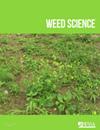Characterization of MCPA Resistance in Palmer amaranth (Amaranthus palmeri)
IF 2.5
2区 农林科学
Q2 AGRONOMY
引用次数: 0
Abstract
Abstract Phenoxy herbicides (2,4-D and MCPA) are widely used to manage broadleaf weeds including Palmer amaranth ( Amaranthus palmeri S. Watson), one of the most troublesome weeds in the US cropping systems. Previously, we documented resistance to 2,4-D and MCPA in an A. palmeri population (KCTR) from Kansas. Our recent research suggested rapid metabolism of 2,4-D bestows resistance in KCTR A. palmeri ; nonetheless, the mechanism of MCPA resistance in this population is still unknown. The objectives of this research were to 1) evaluate the level of resistance to MCPA in KCTR compared to two known susceptible populations of A. palmeri , MSS and KSS, 2) study the absorption and translocation of [ 14 C]MCPA in KCTR and MSS plants, 3) investigate the metabolic profile of [ 14 C]MCPA in KCTR, MSS, and compare those with MCPA-tolerant wheat ( Triticum aestivum L.) plants, and 4) assess the possible role of cytochrome P450 enzymes (P450s) in MCPA metabolism. Experiments were conducted to assess the level of resistance in KCTR. Using [ 14 C]MCPA, the absorption, translocation, and metabolic profiles were assessed in A. palmeri . Involvement of P450s was confirmed using malathion, a known P450-inhibitor. Regression analyses indicate that KCTR population exhibits a ∼3-fold resistance to MCPA. No difference in absorption of [ 14 C]MCPA was found between MSS or KCTR. However, the KCTR plants translocated less [ 14 C]MCPA at 48 hours after treatment (HAT) and metabolized more MCPA rapidly than MSS plants at 12 and 24 HAT. MCPA resistance in KCTR was reversed upon treatment with malathion indicating the involvement of P450s in metabolism of this herbicide. This is the first report of characterization of MCPA resistance in A. palmeri .苋属植物MCPA抗性的研究
摘要苯氧类除草剂(2,4- d和MCPA)被广泛用于治理阔叶杂草,包括苋菜(Amaranthus palmeri S. Watson),这是美国种植系统中最棘手的杂草之一。先前,我们记录了来自堪萨斯州的A. palmeri种群(KCTR)对2,4- d和MCPA的耐药性。我们最近的研究表明,在KCTR A. palmeri中2,4- d的快速代谢具有抗性;尽管如此,MCPA在该人群中的耐药机制仍不清楚。本研究的目标是1)评估的抗2甲4氯水平KCTR两个已知的a . palmeri易感人群相比,海量存储系统(MSS)中,KSS、2)研究(14 C)的吸收和易位2甲4氯在KCTR和海量存储系统(MSS)中植物,3)调查[14 C]的代谢剖面2甲4氯在KCTR,海量存储系统(MSS)中,和比较那些MCPA-tolerant小麦(小麦l .)植物,和4)评估可能的细胞色素P450酶的作用(P450) 2甲4氯的新陈代谢。通过试验对KCTR的抗性水平进行了评价。使用[14c]MCPA,评估了A. palmeri的吸收、易位和代谢谱。使用马拉硫磷(一种已知的p450抑制剂)证实了p450的参与。回归分析表明,KCTR群体对MCPA表现出~ 3倍的抗性。MSS和KCTR对[14 C]MCPA的吸收没有差异。然而,与MSS植株相比,KCTR植株在处理后48小时(HAT)转运的[14 C]MCPA较少,并且在12和24 HAT时代谢的MCPA更快。马拉硫磷处理后,KCTR对MCPA的抗性逆转,表明p450参与了该除草剂的代谢。这是首次报道棕榈芽孢杆菌对MCPA的耐药性。
本文章由计算机程序翻译,如有差异,请以英文原文为准。
求助全文
约1分钟内获得全文
求助全文
来源期刊

Weed Science
农林科学-农艺学
CiteScore
4.60
自引率
12.00%
发文量
64
审稿时长
12-24 weeks
期刊介绍:
Weed Science publishes original research and scholarship in the form of peer-reviewed articles focused on fundamental research directly related to all aspects of weed science in agricultural systems. Topics for Weed Science include:
- the biology and ecology of weeds in agricultural, forestry, aquatic, turf, recreational, rights-of-way and other settings, genetics of weeds
- herbicide resistance, chemistry, biochemistry, physiology and molecular action of herbicides and plant growth regulators used to manage undesirable vegetation
- ecology of cropping and other agricultural systems as they relate to weed management
- biological and ecological aspects of weed control tools including biological agents, and herbicide resistant crops
- effect of weed management on soil, air and water.
 求助内容:
求助内容: 应助结果提醒方式:
应助结果提醒方式:


